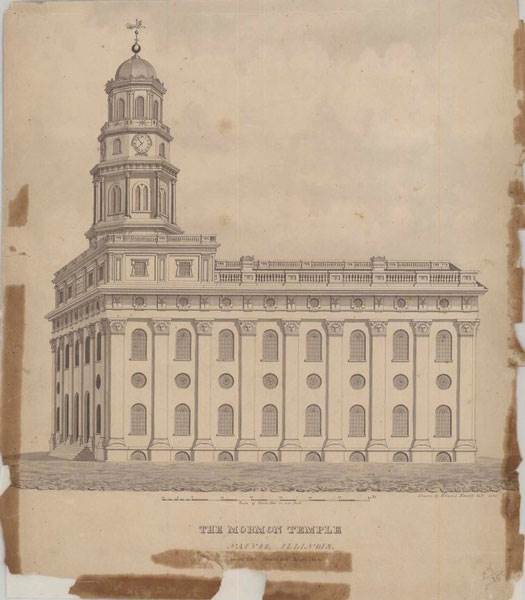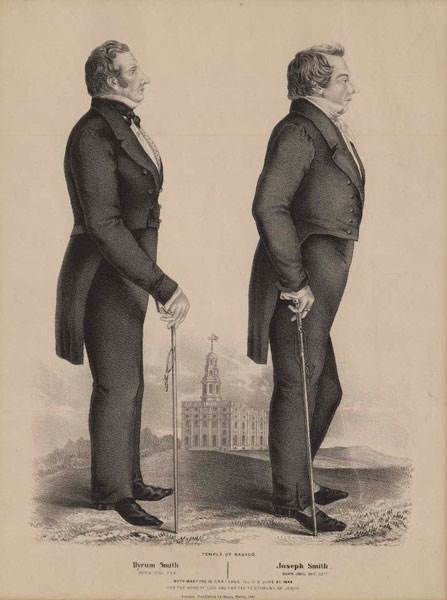In its January 1, 1851, issue, the New York Herald included a day-by-day chronicle of events from 1850. For May 27, it listed "Terrible tornado at Nauvoo; the Mormon temple entirely destroyed."The temple at Nauvoo had been a monument of a time when the town in west-central Illinois was the center of the Mormon faith.
Many of the Mormons who first arrived in Illinois did so as refugees, fleeing persecution in Missouri across the Mississippi River to Quincy. Soon, they sought to buy land in the small town of Commerce in Hancock County, which they would rechristen "Nauvoo" from a Hebrew word that Smith said "signifies a beautiful situation." Thousands of Mormons had come to the town from the United States and abroad by the early 1840s.
Envisioning Nauvoo as a city of God, Smith and his followers planned to erect a grand temple for worship. On April 6, 1841 they laid the cornerstones for the temple. Though never entirely finished, builders added a roof in 1845, and worshipers began holding religious ceremonies into early 1846 (and perhaps as late as 1848 when the church sold the temple).
 An artist's depiction of the Nauvoo Mormon Temple in 1846.
An artist's depiction of the Nauvoo Mormon Temple in 1846.
(Abraham Lincoln Presidential Library and Museum)
As Smith oversaw the construction of the new temple, he also entered into the first plural marriage in the Mormon Church and soon after began revealing church doctrine that supported the practice. Smith and other church members took part in this practice in secret at first. Within the next three years Smith would have over thirty wives.
Shaped by their experience with persecution in Missouri, Smith and his followers attempted to create an autonomous city in Illinois. The city formed the Nauvoo Legion as a militia to protect the town. Smith's followers also voted in blocs, often directed by Smith, making the Mormon vote a powerful method of gaining allies in government. When those alliances failed, and Illinois officials attempted to extradite Smith back to Missouri for trial, Nauvoo claimed the authority to judge the legality of warrants against its residents.
The appearance of a local militia under the command of Joseph Smith, the overt conflation of church and politics in Nauvoo, and the town's extraordinary claims of legal powers that superseded the state's authority worried other Illinois residents.
 Artist's depiction of Hyrum and Joseph Smith with the Nauvoo Mormon Temple in the background. (ALPLM)
Artist's depiction of Hyrum and Joseph Smith with the Nauvoo Mormon Temple in the background. (ALPLM)
As news of Smith's polygamy spread through Nauvoo, resistance sprouted among Smith's followers as well. These dissenters started a newspaper called the Nauvoo Expositor and made public accusations against Smith that included directing the votes of Nauvoo residents, merging the practices of church and state, and polygamy. Smith encouraged the town council to suppress the Expositor, and the Nauvoo Legion brought over 200 armed men down on the newspaper and destroyed its printing press.
Smith later surrendered himself to county officials on the charge of rioting for attacking the Expositor and was shot and killed by a mob from nearby Warsaw, Illinois, while imprisoned.
Unable to find peaceful coexistence in Illinois, Mormon leaders began leaving in mid-February 1846. Not long after their departure, a fire destroyed much of the Nauvoo temple's interior. The outer shell remained intact until the 1850 tornado. Today Nauvoo is a national historic district that includes a reconstructed temple administered by the Church of Jesus Christ of Latter-day Saints.
Jacob K. Friefeld
Research Historian